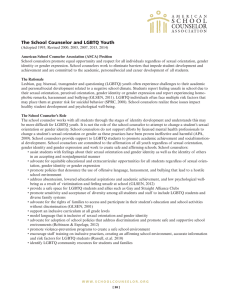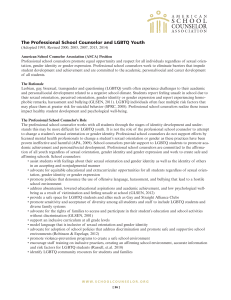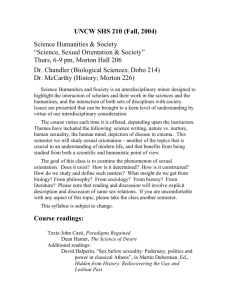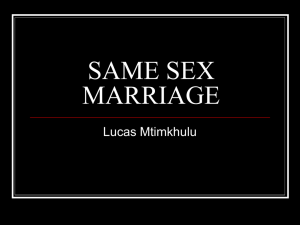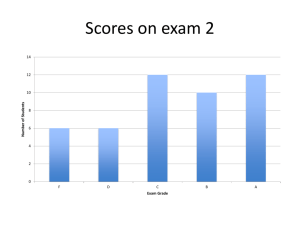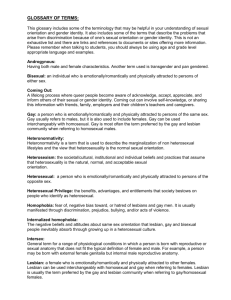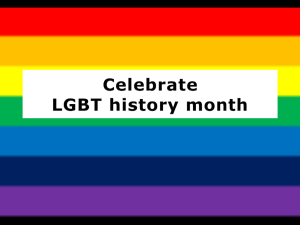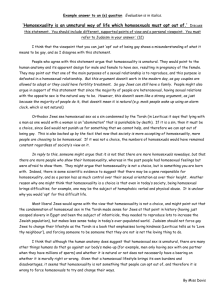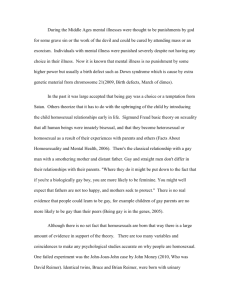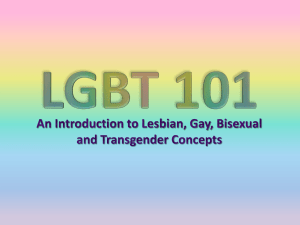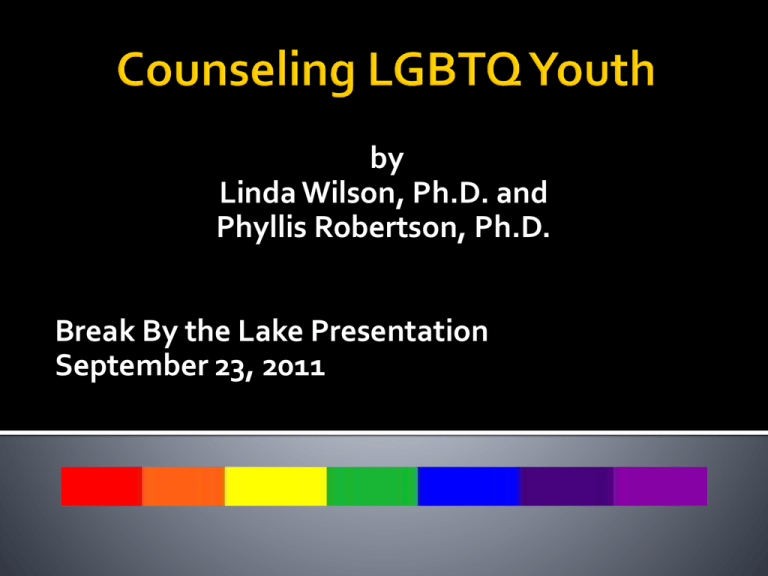
by
Linda Wilson, Ph.D. and
Phyllis Robertson, Ph.D.
Break By the Lake Presentation
September 23, 2011
Improve understanding of ethical guidelines
for working with LGBTQ youth.
Provide affirming counselors with an
understanding of gay youth identity
development models.
Increase our awareness of client perceived
insensitivity and lack of knowledge on our
parts.
Begin to understand what experiences,
thoughts, and behaviors are normal for
LGBTQ youth.
Predict future experiences for prevention and
education purposes
Identify areas for concern or indications of
pathology
Shorten the lens of our own blind spots.
Psychologists understand that
homosexuality and bisexuality are not
indicative of mental illness.
Psychologists strive to understand how a
person's homosexual or bisexual orientation
may have an impact on his or her family of
origin and the relationship to that family of
origin.
Psychologists strive to understand the
special problems and risks that exist for
lesbian, gay, and bisexual youth.
Psychologists make reasonable efforts to
familiarize themselves with relevant mental
health, educational, and community
resources for lesbian, gay, and bisexual
people.
Guidelines for Psychotherapy http://www.apa.org/practice/guidelines/glbt.pdf
Counselors are aware of their own
values, attitudes, beliefs, and behaviors
and avoid imposing values that are inconsistent
with counseling goals. Counselors respect the
diversity of clients, trainees, and research
participants. (A. 4. b.)
When appropriate, counselors advocate at
individual, group, institutional, and societal
levels to examine potential barriers and
obstacles that inhibit access and/or the growth
and development of clients. (A.6.a.)
Standard C.2.b. ("New Specialty Areas of Practice"),
"Counselors practice in specialty areas new to them
only after appropriate education, training and
supervised experience. While developing skills in
new specialty areas, counselors take steps to ensure
the competence of their work and to protect others
from possible harm." Therefore, any professional
engaging in conversion therapy must have received
appropriate training in such a treatment modality
with the requisite supervision. There is, however, no
professional training condoned by ACA or other
prominent mental health associations that would
prepare counselors to provide conversion therapy.
Professional school counselors promote affirmation,
respect and equal opportunity for all individuals
regardless of sexual orientation or gender identity.
Professional school counselors also promote
awareness of issues related to sexual
orientation/gender identity among students,
teachers, administrators, parents and the
community.
Professional school counselors work to eliminate
barriers that impede student development and
achievement and are committed to the academic,
career and personal/social development of all
students.
Position Statement
http://asca2.timberlakepublishing.com//files/PS_LGBTQ.pdf
Cass – 1979 6 stage process based on
“coming out” experiences in life
Troiden- 1989 4 stages that allow for options
in social realities of disclosure
McCarn and Fassinger 1996 4 phases that
distinguish between two processes: individual
identity development and minority group
identity membership
•
•
•
•
Sensitization
Identity confusion
Identity assumption
Commitment
Troiden, 1998
Sensitization
Usually occurs prior to puberty
Generalized feelings of marginality
Perception of being different from same-sex peers
More than 70% of adult homosexuals felt somewhat
or very much different from same-sex peers in
childhood
This difference was not usually labeled as sexual
differentness or homosexuality
Troiden, 1998
School culture conveys respect and enjoyment of
diversity
Policies to prevent verbal/physical harassment
Harassment understood as hate-based and dealt with
in same manner as hatred of gender, race, religion
Offender educated about how language is offensive
Homosexuality incorporated into school forums
Parents of students who are different from the
“norm” are encouraged to accept and nurture their
children’s unique self-identities
Individual counseling recommended
Bellonci 1995
Identity confusion
Same-sex arousal or activity; absence of
heterosexual arousal
Reflection on whether feelings or behavior could be
considered homosexual
Dissonance from previously-held self-image
Identity confusion, inner turmoil, anxiety
Guilt, need for secrecy, social isolation
Self-labeling may be impeded by lack of role
models or bizarre stereotypes
Troiden, 1988
Creation of ‘safe spaces’ and role models within
the school
Group counseling recommended
Gay/Straight alliances or school clubs
Counselors give youth the clear message they do
not view homosexuality negatively or refer youth
to a gay-affirmative agency for support if they are
uninformed or uncomfortable with this subject
Counselor’s use of language is key. Assumption of
heterosexuality may close the door to further
discussion
Bellonci 1995
Identity assumption
Homosexuality identity is established and shared
with others
Self-definition as homosexual
Tolerance of a gay or lesbian identity
Association with other gays and lesbians
Sexual experimentation
Exploration of the homosexual subculture
Self-acceptance as gay or lesbian
Troiden, 1988
Protection of school officials may be needed for
students who ‘come out’ in the school setting
Knowledge of community resources and family
support for gay/lesbian/bisexual youth
Assessment of what supports the youth hasfamily, friends? Who knows? Reaction of others?
Group counseling recommended
Youth at this stage need someone to listen,
reassure, support, no overreaction
Confidentiality regarding sexual orientation
Bellonci 1995
Commitment
Homosexuality adopted as a way of life
Integration of sexuality and emotionality
Commitment to a same-sex love relationships
Disclosure of homosexual identity to nonhomosexuals
Shift to different types of stigma management
Homosexual identity considered valid and
satisfying
Troiden,
1988
School needs less of the focus as youth
become more integrated into the gay culture
Individual counseling recommended
Community resources for gay/lesbian/bisexual
youth and how to access them
If no community resources, counselor can help
youth problem solve ways to appropriately
meet others and integrate their sexual
identity into their lives
Bellonci 1995
Branches of model
Individual Sexual Identity
Group Member Sexual Identity
Phases- Awareness
Exploration
Deepening/Commitment
Internalization/Synthesis
Basic Assumptions of Model
Several phases simultaneously
Not every phase is experienced
Process can be lengthy
Can be applied to lesbian and gay male identity
development
Table of Inclusive Model (handout)
Variations in perception of benefits of
“coming out.”
occupational environment
geographical location
racial/ethnic group membership
family situation
legal and economic realities
support systems
“… disclosure is so profoundly affected by
environmental oppression that to use it as
an index of identity development directly
forces an individual to take responsibility
for her own victimization.” McCarn & Fassinger, 1996, p. 522
“Women and men are more likely to come
out in the context of a relationship as
opposed to an independent process of
articulating and acting on sexual desire.”
McCarn & Fassinger, 19196, p.
518
Movement in one area of identity may not be
congruent with movement in the other.
high individual/low group
low individual/high group
In groups of 4-5 read the scenario and the
three counselor responses.
Respond to the questions at the end of the
page in your group.
Prepare to discuss your findings with the
whole group.
Thank you and evaluations


